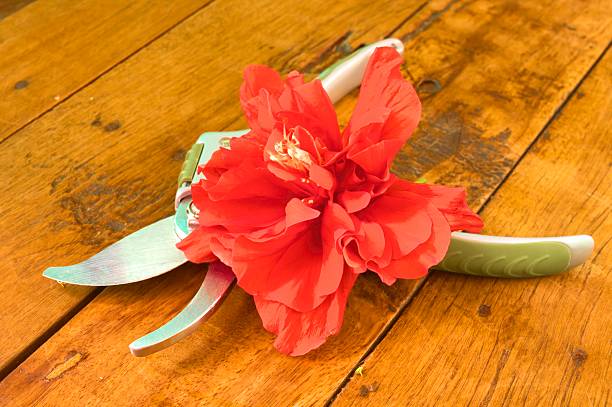Table of Contents
Are you looking to add tropical vibes to your garden or indoor space? Look no further than the stunning and vibrant hibiscus plant. With its large, showy blooms in various colours, from reds and pinks to yellows and oranges, this plant will make a statement wherever you choose to grow it.
But do you know when to prune hibiscus, and how do you care for this exotic beauty? Hibiscus belongs to the mallow family called Malvaceae. They are available worldwide in more warm temperate regions and boast over 100 species. You will be shocked to know that they promote weight loss and are known to reduce the growth of bacteria and cancer cells in the body.
The post shares tips and tricks for successfully growing and maintaining healthy hibiscus plants. Get prepared to change your area into a lush paradise with these specialist hibiscus plant care tips!
Steps for Planting and Nurturing Hibiscus
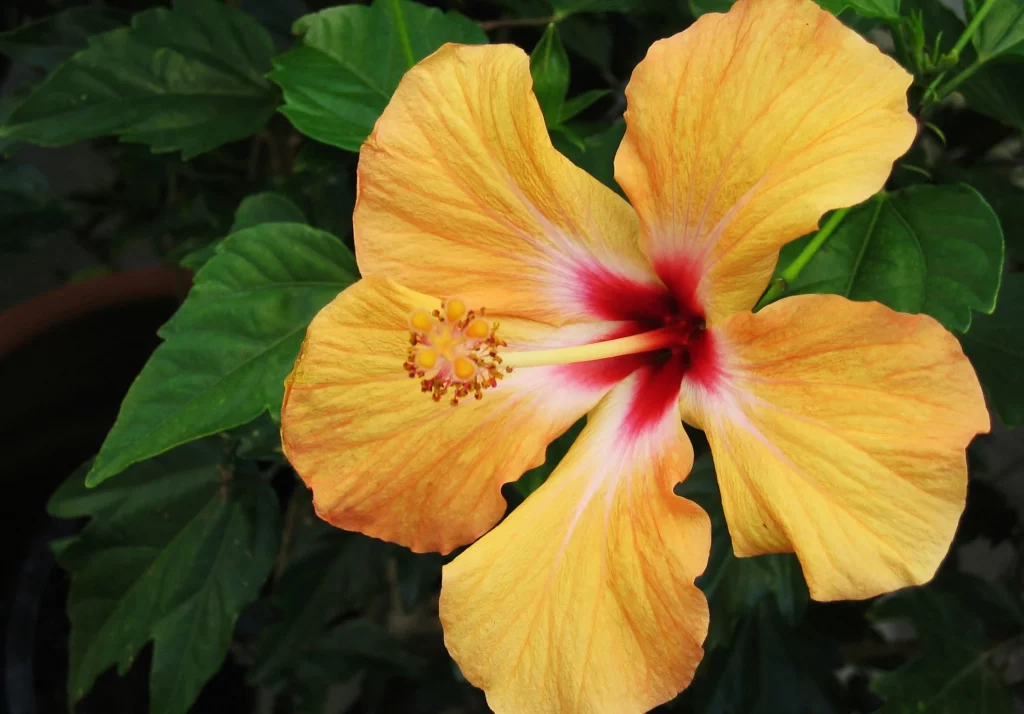
Hibiscus is an attractive blossoming shrub that is simple to cultivate and care for. Its vibrant and flamboyant blooms can improve the attractiveness of any yard or terrain. If you want to plant hibiscus, here are some guidelines you can adhere to guarantee its robust growth:
Planting:
- Select an adequate place: Locate an area that receives at least six hours of sunshine daily and has sufficient drainage. Bear in mind that dim surroundings aren’t ideal for these shrubs.
- Create a hole: Create a hole twice as wide and deep as the root ball.
- Include fertiliser: Incorporate a slow-release fertiliser into the soil towards the hole’s rear.
- Place the plant: Carefully remove it from its container and place it in the hole. Ensure the pinnacle of the root ball is staged with the soil surface.
- Backfill the hole: Fill the gap with soil, ensuring the plant is firmly planted.
- Water: Water the plant nicely to assist it in settling into its new home.
Caring:
- Watering: Water the hibiscus regularly, particularly during dry spells. Make sure the soil is moist and no longer soggy.
- Fertilising: Hibiscus wants ordinary fertilising to promote healthful boom and flowering. Use a balanced fertiliser every 4-6 weeks during the growing season.
- Pruning: Hibiscus benefits from regular pruning to maintain shape and promote bushy growth. Prune in late winter or early spring before new growth appears.
- Pest control: Watch for pests such as aphids and spider mites. Use a natural insecticide if necessary.
- Winter protection: Hibiscus is not cold-hardy and needs protection from frost and freezing temperatures. Bring potted plants indoors or cover outdoor plants with a blanket or sheet if frost is expected.
If you care for your hibiscus plant like this, you may enjoy its stunning blooms for years.
How to Fertilise a Hibiscus Plant?
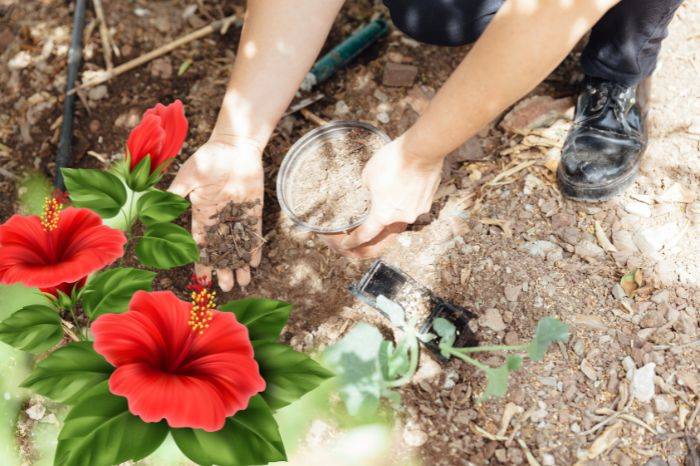
Maintaining the health and vitality of your hibiscus requires regular fertilisation. However, fertilising too much can harm the plant, so following the manufacturer’s instructions is essential. Hibiscus plants should be fertilised every two weeks. Before the plant has had a chance to warm up for the day, fertilising is best done. This prevents the nutrients from evaporating before the plant can utilise them.
Use a fertiliser that dissolves in water and is high in phosphorus. Fertilisers with a high phosphorus concentration will encourage abundant flowering in your hibiscus. Carefully work the fertiliser solution into the soil around the plant’s base, avoiding the leaves and stems. Deeply soaking the soil following fertiliser application aids absorption by the plant’s roots.
Tips for Pruning and Trimming Your Hibiscus Plant
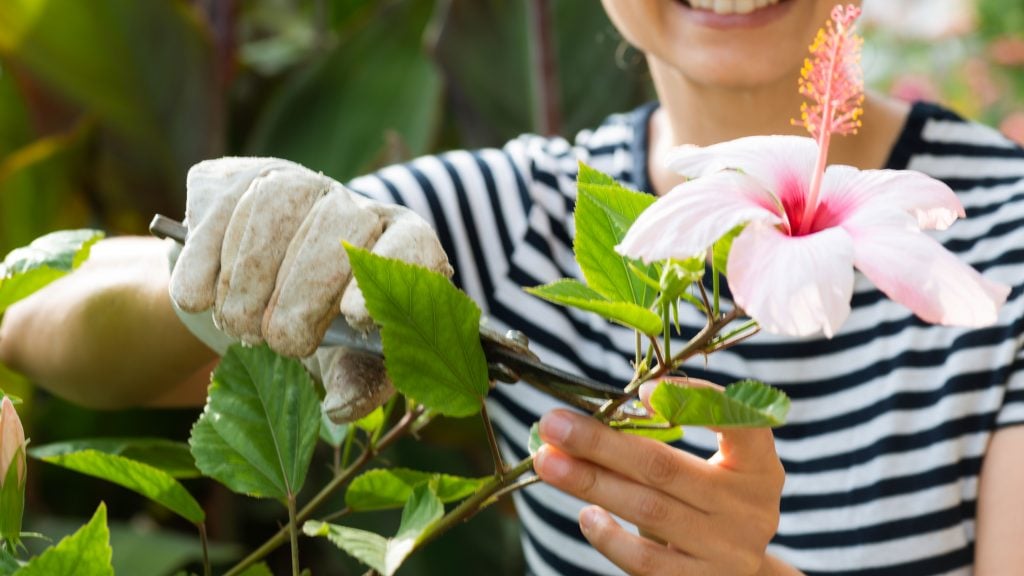
Large, multicoloured blooms are the most recognizable characteristic of the hibiscus plant. Regular pruning and trimming are necessary for these plants to keep their form and flourish. Here are the instructions for how and when to prune hibiscus plants successfully:
- Pick the right time to prune: Winter or early spring, when the plant is dormant and not actively growing. When the plant is actively growing and blooming, summer and fall are the worst times to prune it.
- Utilise Appropriate Equipment: Use sharp pruning shears or scissors to make clean cuts and avoid damaging the plant. Sterilise your pruning tools before use to prevent the spread of disease.
- Remove dead or damaged branches: Start by removing any dead or damaged branches to promote healthy growth. Cut these branches back to the nearest healthy growth point.
- Thin out the plant: Hibiscus plants can become quite dense over time, reducing airflow and poor growth. To thin out the plant, remove any weak or spindly growth and branches that cross or rub against each other.
- Control the size and shape: If your hibiscus plant has grown too large or is getting out of control, you can prune it back to a more manageable size. Cut back the branches by up to one-third of their length to promote bushier growth and a more compact shape.
- Pinch off the blossoms of new growth as it appears to coax your hibiscus into producing more of the plant’s showy blooms. The plant will respond by sending out new shoots and developing more flower buds.
- Pruning clean-up: It is essential to properly dispose of the hibiscus cuttings when you are through using them. If this is implemented, the spreading of pests and illnesses will be slowed.
Preserving Your Hibiscus Over the Cold Season
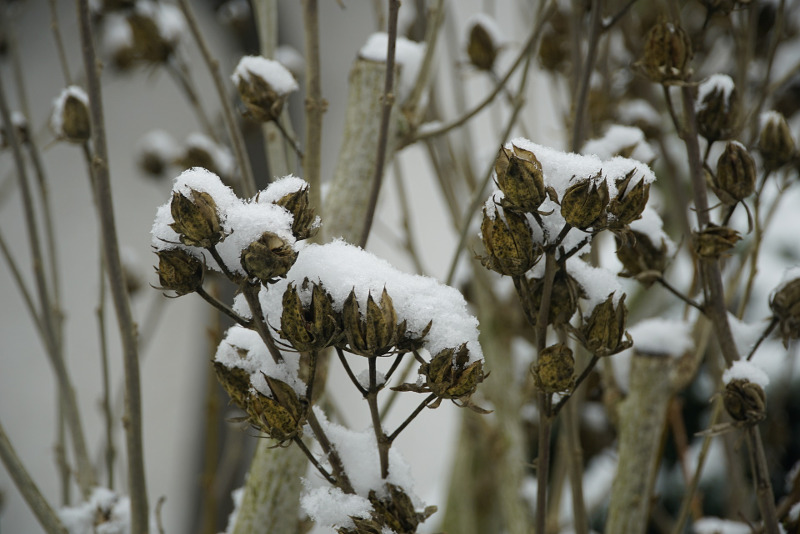
You can keep your hibiscus alive and flowering during the winter by following these steps:
- In the colder months, bring your hibiscus inside. Your hibiscus must be introduced to the interior when the temperature dips beneath 50 degrees Fahrenheit (10 degrees Celsius). Put it next to a south-facing window to ensure it gets adequate light. Placement near dry heating sources such as vents or radiators should be avoided, as should exposure to drafts.
- Modify irrigation schedules: Your hibiscus will need less water in the winter than it would throughout the summer. Overwatering may cause root rot, so let the soil dry out a little before watering again. Also, be sure to use room-temperature water to avoid shocking the plant.
- Reduce fertiliser: In the winter, hibiscus plants are dormant and don’t require as much fertiliser as they do during the growing season. Reduce your fertiliser to about half the average amount, or stop altogether.
- Increase humidity: Insufficient moisture in the indoor atmosphere can result in your hibiscus drying up, shedding foliage, and experiencing tension. To remedy this, boost the moisture level around your flora by situating a humidifier near a dish of water close to the plant. You may also dampen the leaves with water, but exercise caution not to over-saturate them since excessive dampness may cause fungal infections.
- Keep an eye out for pests: Because they are in a closed environment with little airflow, indoor plants are more vulnerable to pests in the winter. Some typical pests that need monitoring are spider mites, mealybugs, and whiteflies. Apply an insecticidal soap or oil spray to the plant if you see any symptoms of infestation.
What Equipment to Use When Pruning Hibiscus?
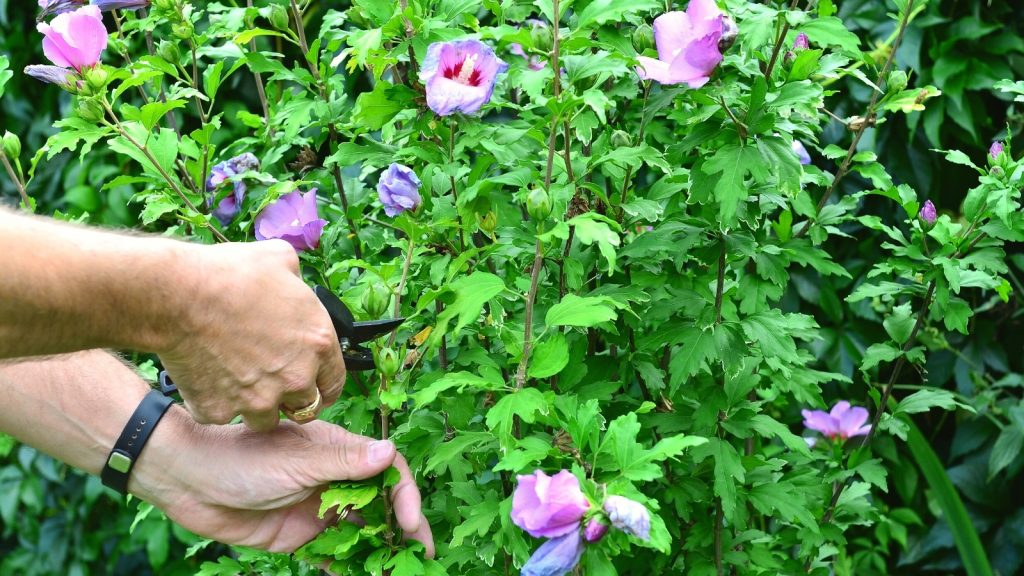
The following are some of the most essential implements for hibiscus pruning:
Pruning Shears
When pruning hibiscus, pruning shears are the single most crucial tool. They come in various sizes and shapes, but using a pair of bypass pruning shears for hibiscus is best. These shears have a curved blade that slides past a straight blade, allowing you to make clean cuts without crushing the stem.
When selecting pruning shears, ensure they are sharp and have a comfortable grip. Dull shears can cause damage to the plant, while uncomfortable grips can lead to hand fatigue and blisters.
Loppers
For larger branches or stems, loppers may be necessary. Loppers have long handles and a scissor-like blade that can cut through branches up to 2 inches thick. Like pruning shears, selecting loppers with a comfortable grip and sharp blades is vital.
Hand Saw
Sometimes, you may need a hand saw to remove larger branches or stems. A pruning saw is a compact hand saw with a curved blade that is ideal for cutting through thicker branches. When selecting a hand saw, ensure it has a comfortable handle and a blade with a durable, sharp edge.
Hedge Shears
Hedge shears are not typically used for pruning hibiscus, but they can help shape the plant and remove dead growth. However, they should only be used on hibiscus trained into a formal hedge or topiary shape. Using hedge shears on untrained hibiscus can cause damage and promote the growth of new shoots that are weak and prone to disease.
The Positive Effects Of Hibiscus Cultivation
Some of the many upsides of caring for a hibiscus plant are listed below.
1. An All-Natural Antioxidant Booster
For ages, people throughout the globe have enjoyed sipping on hibiscus tea. Dried hibiscus flower petals are used to create this product, which is revered for its rich antioxidant content. These antioxidants may help prevent cell damage and chronic illnesses like cancer and heart disease caused by free radicals.
2. The Plant that Requires Little Care
Hibiscus is an excellent option for first-time gardeners or anyone short on time because it requires little care. It prefers a warm, sunny climate, and it has to be watered often and fertilised sometimes to grow well. A hibiscus plant may produce fragrant and colourful flowers for months if given the right conditions.
3. Improves Your Home’s Visual Appeal
A home’s curb appeal may be improved with the help of a hibiscus plant, which comes in a wide variety of colours and variations. Hibiscus plants are a fantastic way to add colour and texture to your garden in containers or on the ground. Additionally, curious neighbours and bystanders will be drawn to the enormous, striking flowers.
4. Draws In Pollinators
Bees, butterflies, and hummingbirds are just some pollinators drawn to hibiscus blossoms. By planting hibiscus in your garden, you can help to support local populations of these essential pollinators, which play a critical role in maintaining healthy ecosystems.
5. Medicinal Properties
In addition to its antioxidant properties, hibiscus has many other potential health benefits. For example, studies have shown that hibiscus tea may help to lower blood pressure and cholesterol levels, improve liver health, and aid in weight loss. While more research is needed to understand hibiscus’s medicinal properties fully, its long history of use in traditional medicine suggests that it may have a range of health benefits.
Final Thoughts!
You now know when to prune hibiscus and how to care for them like a pro. They are a well-liked option for seasoned and inexperienced gardeners due to their beautiful blossoms and simple maintenance requirements. Hibiscus plants may thrive and produce abundant, vibrant blooms if you provide them with the optimum growing conditions, frequent watering and fertilisation, appropriate pruning, and pest and disease control.
Hibiscus plants will undoubtedly provide beauty and happiness to your home and yard, whether you grow them in pots or directly in the ground. Stem cuttings are an easy and efficient approach to growing new hibiscus plants and increase your collection if you’re interested in propagating your hibiscus plant.
Remember that every hibiscus variety has particular care instructions, some of which may differ somewhat from others. With a little TLC, your hibiscus plants can thrive and continue to enliven your room with their vivid and exotic flowers.
Frequently Asked Questions
How Much Soil Do Hibiscus Plants Require?
Hibiscus plants prefer organically rich, well-draining soil. Peat moss, perlite, and vermiculite should all comprise a high-quality hibiscus potting mix. Good quality soil will ensure the optimum health of the plant and the speed of growth.
How Frequently Should I Water My Hibiscus Plant?
Consistently hydrating hibiscus flora is vital, specifically during scorching and arid conditions. Drench your hibiscus twice a week. Avoid excessive watering to avert root decay. Root decaying is a serious problem that will wither your roots and affect the grasping of nutrients by the plant.
When Should Hibiscus Plants Be Fertilised?
Regular fertilisation helps hibiscus plants grow well during the growing season. Use a balanced fertiliser with the same proportions of nutrients to fertilise every four to six weeks. Always ensure to use of high-quality fertiliser to avoid damaging the plant.
Is It Necessary to Trim My Hibiscus Shrub?
Indeed frequent trimming is crucial to preserve the well-being of your hibiscus shrub. Trim at the beginning of spring to get rid of withered or impaired wood and contour the shrub as per your preference. This will ensure that your plant grows in a balanced way.
What Is the Method to Avert Pests and Ailments in My Hibiscus Shrub?
Carry out a routine inspection of your hibiscus shrub to detect any indications of pests or ailments. Eradicate the affected leaves or branches as the earliest. Ensure that the shrub is well-hydrated and fertilised. In addition, prevent overcrowding or overabundance of shade.

